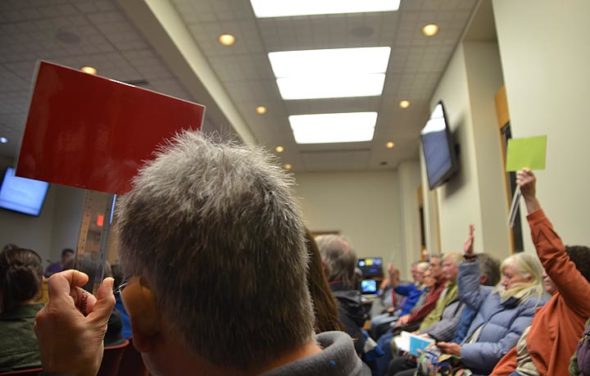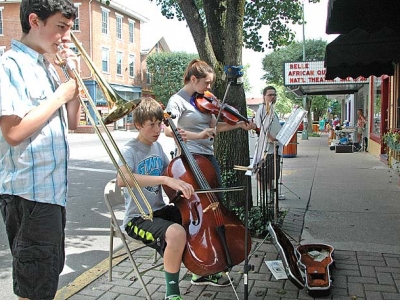
A small group of citizens used signs to express their approval or disapproval of statements made by Council and other citizens during a Village Council meeting in January. Council later banned signs, along with other expressions such as clapping, in a move that some villagers find troublesome. (Photo by Megan Bachman)
Council ban on clapping, signs — Do rules violate free speech?
- Published: May 16, 2019
On January 22, Village Council chambers was standing-room only as more than 50 citizens crammed into the room, many to express their disapproval for an ongoing disciplinary process involving a local police officer.
Some brought small handmade signs colored green on one side and red on the other, or with smiling faces on the front and frowning faces on the back, using them occasionally during the meeting to signal their support or disapproval of a comment made by a Council member or fellow citizen. There was also occasional clapping in support of a public comment.
The signs were an attempt to comply with Council’s previous requests to not clap or snap in meetings. But in March, Council passed a resolution banning the display of signs in Council chambers. At the same time, Council also officially outlawed clapping as well as “verbal approval or disapproval” during meetings.
“In consideration of citizens speaking on any aspect of a matter, no clapping, verbal approval or disapproval or display of signs is permitted in Council Chambers,” the change to Council rules and procedures reads.
Council members and the Council clerk have defended the rules, saying they keep Council meetings running efficiently, prevent the interruption of sound on the live video feed and help maintain decorum. They also posited that audible and visual audience reactions might be discouraging villagers from speaking opposing views.
Council President Brian Housh said in a recent interview one reason for the rule change is to make Council a more civil and safe space that is “encouraging all people to share their viewpoints.”
“If you’re in the miniority it’s going to be hard to speak up when you realize you are in a room where everyone has a different view,” Housh said.
Almost immediately, some citizens questioned whether Council’s action infringed on their First Amendment right of freedom of speech. In letters-to-the-editor, on social media and in conversations around town, they argued that it was anti-democratic and possibly illegal. Some suggested that Council’s action was in direct response to receiving criticism about Village efforts to discipline the officer and thus an attempt to silence those viewpoints.
Former Council member Judith Hempfling believes that limiting clapping and other expression will not lead to the “vigorous exchange of views” that Council should promote in its meetings. She sees clapping, for one, as a form of expression that should be protected.
“It’s the way in our society we express approval of something,” Hempfling said. “Do we really want to suppress speech to protect it?”
Council members have promised to revisit the issue at an upcoming meeting and gather additional citizen perspectives.
This week, Council Vice President MacQueen shared her perspective on the measure and desire for more feedback on it.
“Every voice needs to be heard and people need to not be intimidated,” MacQueen said of the rationale behind the measure.
But MacQueen added that she was later uncomfortable with the decision Council made to impose the restrictions.
“I would like to see Council and the community come up with guidelines of engagement. I don’t want it to be something that Council imposes.”
This week the News looks at the arguments on both sides of the issue and explores outside legal perspectives on whether Council’s action was in keeping with state and federal law. In an upcoming article, the News will look at how public comments are handled in other public bodies and groups.
A matter of free speech
According to Ohio law, public bodies aren’t required to hear public comments at all during their meetings.
The Ohio Open Meetings Act specifies that citizens have a “right to hear but not to be heard or to disrupt.” The 2018 Ohio Sunshine Law manual explains it this way: “The Open Meetings Act does not provide (or prohibit) attendees the right to be heard at meetings.”
But how much leeway do public bodies have in restricting comments if they allow them?
If public participation at a meeting is allowed, then speakers are protected by the First and Fourteenth Amendments of the U.S. Constitution, courts have found.
According to Elizabeth Bonham, staff attorney for the American Civil Liberties Union of Ohio, “the degree of First Amendment free speech rights depends upon where you are.”
“If I’m on private property, I don’t have free speech rights at all,” Bonham said. “If I am on public property, it depends upon what kind.”
On sidewalks, in city parks and other places where people typically congregate, free speech rights are at their maximum, Bonham said. Those places are called “traditional public forums.”
But what of Council meetings? According to Bonham, they are seen as “limited public forums,” in which the government may regulate the “time, place and manner” of speech. However, there are limits.
“The government has to do it in a way that doesn’t silence a particular type of view,” Bonham said.
According to the Ohio Sunshine Manual, public bodies may limit speech as long as the restrictions are “content neutral” and “narrowly tailored to serve a significant governmental interest.”
Looking at Yellow Springs Village Council’s resolution, Lata Mott, a lawyer and executive director of the First Amendment Center in Washington, D.C., is not sure it passes constitutional muster. The litmus test is whether such restrictions are “content neutral” and have a “reasonable or rational basis,” she said. And she finds problems with the local resolution on both counts.
Although not apparently geared toward stifling certain views, the measure nevertheless seems to take aim at views critical of municipal policies, Mott believes.
“If you allow people to speak but not if they are critical of city policies, that is content discrimination,” she said.
To Mott, the legal difficulty comes with enforcement of the measure. On the face of it the resolution “looks like it’s content neutral.” But Mott worries how it might actually be enforced.
“I can see it not being enforced when people are clapping in admiration of the Council and enforced when they are not clapping in admiration,” Mott said.
In addition, Mott found problems with “rationale or reasonable basis” behind the measure. Specifically, she finds the targeting of signs troubling.
Prior court decisions have upheld measures to curb disruptive behaviors, such as not speaking on topic or making threatening or aggressive statements.
“A disruptive person waives his or her right to attend meetings, and the body may remove that person from the meeting,” the Ohio Sunshine Manual states.
However, Mott finds contradiction in the Village policy on that matter.
“It is not just aimed at disruptive speech,” Mott said. “The signs are less disruptive than clapping. If the basis is to stop disruption, banning signs doesn’t make sense.”
If the signs were impeding the view of other citizens in the meeting, their ban might be justified, Mott added.
When it comes to types of speech covered by the First Amendment, Mott said it has been pretty broadly defined, offering a partial list: “Media, TV, radio, music, dance, hand gestures, burning of the flag, wearing a T-shirt that says something.”
“Clapping and snapping are less weird than those,” Mott said.
Mott also said she also finds the Village’s rules overly vague and broad, which could be problematic.
“Generally when something is overly vague it is going to run into First Amendment issues,” Mott said. “If people aren’t sure what will be banned or not it will have a chilling effect on their speech.”
“It covers a lot of different types of conduct and that makes it hard to know what is allowed or not,” Mott added of the resolution.
In the end, Mott understands that councils don’t want citizens to be afraid to speak in a public meeting. Yet she is hesitant to endorse a policy that “suppresses speech to support it.” While bans on booing and heckling might withstand judicial scrutiny, clapping, she feels, would not.
“Clapping is an approved and traditional way to react to speakers. I don’t think they should ban that.”
The need to regulate public comment
Clerk of Council Judy Kintner believes that all citizens who attend Council meetings should be treated fairly and consistently and should have the opportunity to speak their views. In fact, the new rules are a way to do just that, she wrote in a recent email.
For instance, if clapping is permitted, then booing must also be permitted, since they are both speech, Kintner wrote.
“We do not permit booing, therefore, to be consistent in our message — which should be that anyone has the right to speak, be heard, be treated respectfully — that would mean we would not permit any behavior that would chill that speech,” Kinter wrote.
Kintner sees that such rules are part of Council’s purview, pointing to Section 20 of the Village Charter.
“The Council shall determine its own rules and order of business,” the section reads.
First and foremost, Council meetings are to “conduct the business of Council,” according to Kintner. Public input has its place, and it should be respectfully heard, but not responded to. However, there is a difference between public participation in Council meetings and public input.
“The public is not permitted to participate in Council meetings. They may give input,” Kintner wrote.
The new rules, Kintner believes, will help keep Council meetings in order and give citizens more clear expectations.
“That inconsistency has created problems, as some Council members regularly respond and in some cases disagree with/engage with the speaker,” she wrote.
Council President Housh is a strong supporter of the public comment period in Council meetings, he said in a recent interview.
“This is the norm we’ve set for Yellow Springs and it’s not something I’m going to change while I’m on Council,” Housh said of accepting citizen comments.
“It adds value and it highlights the Village value we have for facilitating public participation,” he added.
At the same time, Housh said, citizens should recognize that Council “has a lot of issues to cover, and there has to be a balance,” which is why he believes other municipalities don’t entertain much public feedback.
“Council is not as efficient as it could be, not that efficiency is the only objective,” Housh said.
Housh also described an email from a citizen who stated they couldn’t hear comments while watching the meeting livestream on YouTube due to the loudness of clapping.
“It was starting to be disruptive,” Housh said of clapping at one meeting in particular, attended by many supporters of the officer. At that point, “I started to reconsider my laissez-fair attitude,” Housh said.
Finally, Housh was moved to consider the measures to make sure that Council is a safe space for a multiplicity of views. Clapping, in particuarly, he finds troubling in a public meeting, except under certain circumstances.
“If it was a rally, [clapping] would be the norm, but I don’t see a solid place for it in a Council meeting, which is ultimately about getting work done,” Housh said.
“I can see clapping about someone getting an award, but not about the sharing of opinions,” he added.
Housh said he doesn’t understand the need to clap, and that when people clap, he is not moved to take their opinoin.
“Packing a room and clapping is not going to convince me or any other Council member that that’s the only perspective,” he said.
Finally, Housh believes that those who think Council is intentionally “shutting down criticism” by enacting the new rules are circulating “disinformation” that they know is not true.
“That is so off base,” he said.
Council Member Kevin Stokes affirmed his belief that Council is not “shutting people down” by passing the measure. He questioned whether it would actually be enforced.
Stokes said the rules were amended because of those who continued to clap even after they were asked to refrain.
“From my perspective, this is just about decorum,” Stokes said. “We wouldn’t be here if the people we asked to stop, stopped.”
At the same time, the measure is not aimed at a certain method of expression.
“It’s not anti-clapping. It’s anti-distrubance,” Stokes said.
Council Vice President MacQueen feels that audience clapping in support of a statement can become a “tyranny of the majority.”
“It makes it difficult to speak other views,” MacQueen said.
But MacQueen wants to hear more from the community about how to have “productive discussions” in Council meetings. She also hopes the community understands the need to balance Council’s official business with a comment period she believes is important.
“Community members should feel like their voice is heard and taken into account. That it’s integrated.”
The next article will explore how other public bodies handle public comments, the guidance from local government associations and alternative expressive methods used by other groups.














No comments yet for this article.